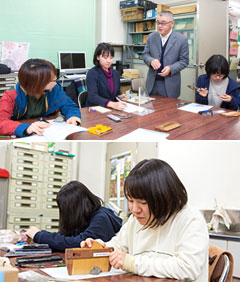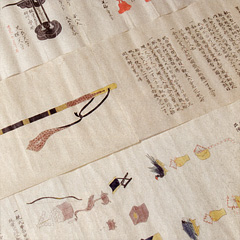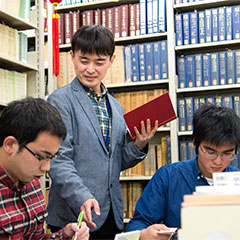Course of History
An unending conversation between past and present. How did people live in the past?
In this course, you can study Japanese history, East Asian history, European history, and archaeology.
The materials used in this discipline range from documents to monographs, but all of these address humankind's past. All of you no doubt studied Japanese history and world history in high school. Studying history at a university, however, challenges you to not just study existing images of history, but draw a new image of history yourself. This requires you to not only direct an eye on the past, but also direct an acute eye on the world today. The Course of History will enrich your sensitivity through a conversation between the past and the present.
| [Majors] | ê Japanese History ê East Asian History ê European History ê Archaeology |
|---|
Japanese History
Although this is a common feature that could be said about all history, the important thing when studying Japanese history is how you come face to face with the past. Although written historical records such as old documents, diaries, and letters are an important for knowing our past, these should be read in a spirit of starting a conversation with the people who wrote them, as these records reveal many truths about the reality of the politics and society of their era and the way of life of the people who wrote them. And from there, we can learn what sort of era is the present, and how we should clear the way for the feature.
The Japanese history program in the School of Humanities of Kanazawa University seeks to impart the way of encountering the past described above, and communicate the joy of studying history. The instruction falls into the four categories of introductions, special lectures, exercises, and training, but of these, training emphasizes elucidating ancient documents written in classical Chinese or Japanese cursive to learn indispensible knowledge and techniques for advancing research. During this coursework, you will go on field trips to nearby ruins, archives, and museums. Kanazawa, where this program is located, achieved a unique historical development as the main base of the Ikko Uprising, the castle town of the fief of Kaga, the richest fief in Japan, and a city at the center of a region undamaged during World War II. The area surrounding this school is also rich in reference facilities for studying regional history, such as prefectural historical buildings and modern archives. In this sense, Kanazawa University can be called a greatly blessed environment for studying Japanese history.
East Asian History
"Let's sketch East Asian history while touching historical records!"
The aim of the East Asian History major is to reconstruct history, mainly from archival records, and reach a profound understanding of the features of the history of East Asia, especially China and the Korean peninsula through this reconstruction.
The number of the faculty members is four. Taken together, the research fields of each of the faculties cover the Later Han, Wei-Jin, and Northern and Southern Dynasties, and nearly all of Chinese history from the Tang Dynasty to the Qing Dynasty, and cover a broad range of topics such as cultural history, political history, the history of international exchange, and social economic history.
Although the instruction that is the focus of study is practice and training, this course cultivates basic knowledge and skills through careful reading of historical records using, for example, Japanese readings of Chinese texts or Chinese read aloud, and experience in how to use seals, which are indispensible for research in ancient Chinese history. You will enroll in a number of courses and special lectures focusing on these studies, and engage in detailed study steadily increasing your research skill, interest, and attention, while receiving direct guidance from the faculty of your own research topics. In your senior year, you will complete a graduation thesis that compiles in one work what you have learned since you entered the program. Recent graduation theses have included a consideration of politics and administration in the Ming Dynasty, and a study of the involvement of Japanese pirates in the Korean peninsula.
No matter what period of Chinese history you wish to study, there is a faculty member who handles it, allowing you to grapple with historical records and savor a genuine interest in searching the world of the past by yourself while receiving direct guidance from this faculty member: These are the most characteristic features of the East Asian History program of Kanazawa University.
European History
When you hear "Europe," do you feel, "ah, so far away!"?
While Europe is certainly a considerable distance from Japan, the recent growth of the Internet has made it easy to communicate with Europe. There has also been a considerable increase in TV programs introducing different parts of Europe from World Heritage sites to back roads. It could be said that Europe now feels much closer to us than it did in the past.
The European history study group seeks to know this "faraway, but nearby" Europe from the aspect of history. This involves traveling to a different cultural space to reconstruct history while tracing remaining archives and monographs and treatises written to interpret and study these archives, and exploring the behavior and thinking of the people living in this history. A great success would be if you can feel the people of this period breathing.
The staff members of the European history study group have specialties such as modern English history, history of the Byzantine Empire, and history of the Russian Revolution, and have prepared a variety of instruction programs. You will be asked to study to sharpen your sensitivity while stimulating and being stimulated by your colleagues, to seek an understanding of different cultures, and to reconsider your preconceptions to become a motivator in the Japan of tomorrow.
Teaching Staff

Archaeology
You no doubt already have a vague idea about the discipline called archaeology. It is the study of, for example, the gold treasures excavated from Tutankhamen's tomb, the terra cotta army discovered near the tomb of Qin Shi Huang di, or the Takamatsuzuka Tomb.
Needless to say, these are among the most spectacular results of archaeology. But archaeologists do more than just dig to excavate such splendor. The majority of their work is quiet research collecting and comparing many materials to deduce some sort of conclusion from these materials. Archaeologists consider how features discovered by observing many pottery sherds have changed over time, and surmise influential relations with other regions from the shape of a tomb or the layout of rooms in a residential site Without accumulating such basic work, it would not have been possible to extract the full significance of the great discoveries we noted at the beginning. Thus, archaeology considers human history and culture from the perspective of ruins and remains.
From the lectures in our major, you learn the methods of archaeology from a variety of examples.
Exercises also give you training in putting these methods to work. Because archaeology is a discipline that draws conclusions from ruins and remains, these remains must be accurately recorded to transmit this information to others. You will learn these methods through field archaeology and survey training.
Teaching Staff




